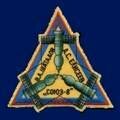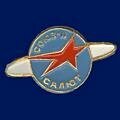SOYUZ MANNED SPACE PROGRAM 1967 - 1971
|
THE EARLY SOYUZ PROGRAMThe Soviets second generation of space craft, the "Soyuz" (Union), consisted of three modules and delivered its electrical power from two solar panels. The docking collar was optionally carried at the front of the spherical orbital module. The descent module included a flight cabin with a heat shield. The instrument module was the last section making up the complete Soyuz craft. The Soyuz space craft was designed to fulfill a number of different roles, in particular as an answer to the American Gemini and Apollo craft with the ability to manoeuvre and dock with other vehicles. Unmanned Soyuz varieties were used as part of the Zond Lunar programme, which tested the equipment and techniques for the planned manned missions. As part of the Soviet's lunar program, the Soyuz craft would be paired up with a one manned lunar lander (LK) and a giant 5 stage launch vehicle (N1), which was similar in size to the American Saturn V. The LK was tested successfully in Earth orbit. The N1 rocket had four launch attempts, all of which failed putting the Soviet's lunar program further behind. When it was apparent the American's would make it to the moon first, the Soviets shifted their goals to that of having a permanent manned space station. The Soyuz craft was the only design to be carried across from the now defunct Lunar programme. The uses of the Soyuz 1 - 11 described here were for Earth orbit missions, culminating in the first manned space station (Salyut). |
||||||||||||||||||||||||||||||||||||||||||||||||||||||||||||||
|
||||||||||||||||||||||||||||||||||||||||||||||||||||||||||||||
 |
SOYUZ 1: As the space race continued, the moon became the next goal. For this the Soviet Union needed a newer larger vehicle and thus the Soyuz space craft was designed. Unfortunately the workmanship was poor and it was rushed in to service. The pilot of the Soyuz series maiden flight, Vladimir Komarov was reluctant before the flight and even Gagarin (the backup crew) protested the readiness of the craft. The unmanned test craft had failed resulting in its destruction. Regardless on 23-April-1967 the Soyuz 1 space craft was launched (the worlds first night space launch). It was plagued with mechanical problems causing the mission to be cut short early. On re-entry the parachutes failed to open, causing the craft to be destroyed on impact. This was the first space craft fatality. | |||||||||||||||||||||||||||||||||||||||||||||||||||||||||||||
 |
SOYUZ 3: Having made automatic docking of two unmanned Soyuz craft in the guise of Cosmos 186 and 188 and also the unmanned Soyuz craft Zond 5, 6 and 7 orbit the moon and return to Earth, the Soviets were readying to attempt the manned flight equivalent missions. Like Apollo 1 to the Americans, the Soyuz 1 disaster had also set the manned Soyuz space flight program back nearly two years. The name "Soyuz" means "union" in Russian and it was always intended that the first flights involve a docking. Piloted by Georgi Beregovoi, Soyuz 3 was not able to perform the planned docking with the unmanned Soyuz 2 craft and Beregovoi was passed over for further flights. | |||||||||||||||||||||||||||||||||||||||||||||||||||||||||||||
 |
SOYUZ 4 & 5: On 14-January-1969 Soyuz 4 and 5 were launched to attempt a docking and crew transfer between two manned craft. This was originally planned for the Soyuz 1 and 2 joint mission but was aborted due to all the technical issues with Soyuz 1 resulting in its loss. The mission was a success with two crew (Yeliseyev, Khrunov) being transferred in flight between the from Soyuz 5 to Soyuz 4 in flight. | |||||||||||||||||||||||||||||||||||||||||||||||||||||||||||||
 |
SOYUZ 6, 7, 8: With the American's beating the Soviets to the moon, the Soviets needed to show they weren't giving up the space program. The focus of the Soviet space program was shifted to an orbital space station, a manned presence in space being their new goal and the next step towards the 60s sci-fi dream of space colonization. The flights of Soyuz 6, 7 and 8 allowed the Soviets the new first of having seven men and three craft in space at once. Although Soyuz 6 lacked the docking equipment and Soyuz 7 and 8 failed to dock, so no crew transfer could occur. | |||||||||||||||||||||||||||||||||||||||||||||||||||||||||||||
 |
SOYUZ 9: Nikolayev from Vostok 3 was one of the crew on this mission, the objective of which was to test the effects of prolonged time in space before the Salyut space stations were launched. | |||||||||||||||||||||||||||||||||||||||||||||||||||||||||||||
 |
SOYUZ 10: For Shatalov and Yeliseyev this was their third flight together after Soyuz 4 and 8 and together with Rukavishnikov they were to make history as being the first Cosmonauts to inhabit the new Salyut space station. Due to technical problems with the Soyuz's hatch jamming the cosmonauts did not enter the space station and as fuel was short they returned to Earth without entering the space station. Further complications occurred when a poisonous gas leak caused a loss of consciousness among the crew before re-entry. They recovered but was a close call. | |||||||||||||||||||||||||||||||||||||||||||||||||||||||||||||
 |
SOYUZ 11: Soyuz 11 was the first flight to occupy Salyut, the worlds first space station, from 6-June to 30-June-1971. The three week mission was highly successful with numerous scientific and biomedical experiments being conducted. Disaster struck as the separation sequence shook open an exhaust valve resulting in depressurisation killing the crew. The crews of all but two of the flights since Voskhod 1 had gone without having space suits in exchange for more crew space. If the crew of Soyuz 11 had been wearing such equipment, they should have survived. This was the worlds first in-space fatality. | |||||||||||||||||||||||||||||||||||||||||||||||||||||||||||||
Soyuz 11 rounded off the first ten years of Soviet manned space flight with a disaster. Over that time the Soviets started by beating the Americans into space and had many firsts only to see the Gemini program overtake them in technology and the Apollo program land a man on the moon. |
||||||||||||||||||||||||||||||||||||||||||||||||||||||||||||||
EARLY SOYUZ SPACE COLLECTION |
|
|---|---|
 First Day
|
 Medals
|
 Soviet Manned Space
|
 Soviet Manned Space
|

